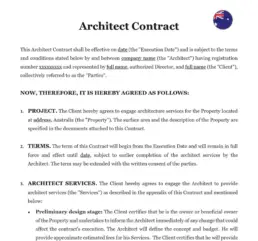The Importance of an Architect Contract
An architect contract is a crucial document that outlines the terms and conditions of the relationship between the client and the architect. This contract ensures that both parties are clear about their roles, responsibilities, and expectations. This guide will provide key insights into drafting effective designer contracts in Australia, with a focus on the importance of the architect contract.
Scope of Work
The scope of work is one of the most critical components of an architect contract. It defines the tasks and deliverables that the architect is responsible for, ensuring that there is no ambiguity about the services to be provided.
1. Detailed Descriptions: Clearly outline the specific services the architect will provide, such as concept design, detailed design, project management, and site visits.
2. Inclusions and Exclusions: Specify what is included in the scope of work and what is not. This helps to prevent misunderstandings and scope creep.
3. Milestones and Deliverables: Define the key milestones and deliverables, such as schematic designs, construction drawings, and final plans.
Payment Terms and Schedules
Payment terms and schedules are crucial for ensuring that the architect is compensated fairly and that the client understands the payment obligations.
1. Fee Structure: Clearly define the fee structure, whether it’s a lump sum, percentage of construction costs, or hourly rates. Include any retainer fees or initial deposits.
2. Payment Schedule: Establish a payment schedule that outlines when payments are due. This could be based on project milestones, monthly invoices, or other agreed-upon criteria.
3. Additional Costs: Specify any additional costs that may arise, such as expenses for travel, materials, or subcontractors. Ensure that these are outlined clearly to avoid disputes.
Project Timeline
A well-defined project timeline helps to keep the project on track and ensures that both parties understand the expected completion dates.
1. Start and End Dates: Clearly state the project’s start and expected end dates. Include deadlines for major milestones and deliverables.
2. Delays and Extensions: Include provisions for handling delays and extensions. Specify the conditions under which extensions may be granted and the process for requesting them.
Roles and Responsibilities
Defining the roles and responsibilities of both the client and the architect is essential for smooth project execution.
| ➤ Architect's Responsibilities: Detail the architect's responsibilities, including design, documentation, project management, and site supervision. |
| ➤ Client's Responsibilities: Specify the client's responsibilities, such as providing timely feedback, making payments, and supplying necessary information. |
| ➤ Subcontractors and Consultants: Address the roles and responsibilities of any subcontractors or consultants involved in the project. Ensure that their obligations are clear and agreed upon. |











